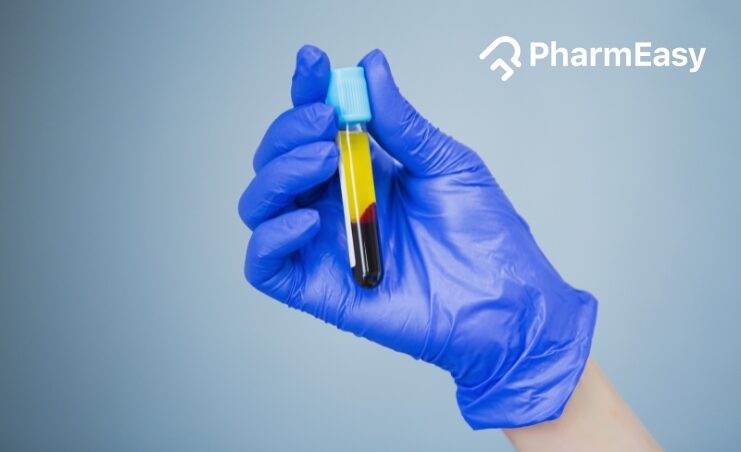PDW Blood Test: Understanding Its Purpose and Results
By Dr. Shubham Pandey +2 more

Get,

to manage your symptom
Get your,


4 Cr+ families
benefitted

OTP sent to 9988776655



You’ve successfully subscribed to receive
doctor-approved tips on
Whatsapp

Get ready to feel your best.

Hi There,
Download the PharmEasy App now!!


Register to Avail the Offer
Send OTPBy continuing, you agree with our Privacy Policy and Terms and Conditions

Hi There,
Sign up on PharmEasy now!!
Trusted by 4 crore+ families

OTP sent to 9988776655



You have unlocked 25% off on medicines




Code: NU25
By Dr. Shubham Pandey +2 more
Table of Contents
The PDW blood test is a medical test that checks for size differences in blood platelets. The main function of platelets includes clotting and ensuring smooth blood flow in the body3.
In this article, we will cover the basics of a PDW blood test. We’ll discuss why it’s done, how it’s done, and what the results mean. We will also touch on the connection between PDW and blood disorders tied to platelets. Lastly, we’ll share ways to get ready for a doctor’s visit for a PDW test.

The role of a PDW (platelet distribution width) blood test is to assess how well a person’s platelets are working whose main function is to create clots and aid in wound repair and stop blood loss3.
PDW test measures the size differences in platelets in a person’s blood. High PDW means that there is a range of platelet sizes, and low PDW suggests more similar sized platelets3. Knowing these variations helps doctors understand how a person’s platelets are functioning.
The purpose of doing a PDW blood test is as follows.
A PDW blood test needs a blood sample from a vein in your arm or hand. Below we have described how to get ready for the test and what happens during the process.
Typically, no unique preparations are needed for a PDW blood test. But if you’re also doing other tests on the same day, your healthcare provider may suggest some things. Always let your provider know about any drugs, vitamins, supplements, or herbal products you’re taking. This avoids an unexpected impact on test results.
During the test, a medic places a small needle into a vein in your arm or hand to take blood. Once they get the sample, it’s sent to a laboratory for study. Though the test is quick and mostly painless, some people might feel dizzy or sick. Deep, slow breaths help lessen these feelings. Also, some people may feel slight pain or see bruises where the needle went in4.
Normal PDW levels fall between 8 to 12 femtoliters. This indicates that your platelets are at peak performance and no medical action is needed3.
Low PDW levels (below 8 femtoliters) could mean that a majority of your platelets are old or that your bone marrow is making fewer platelets than usual3.
High PDW levels (above 12 femtoliters) show higher levels of young platelets in the blood3.
With PDW blood tests, doctors can check for blood disorders tied to platelets. Two common types include thrombocytopenia (low platelet count) and essential thrombocythaemia (high platelet count).
Thrombocytopenia means you have too few platelets in your blood, which raises the risk of bleeding and bruising. Likely causes include problems with the immune system, some medications, and inherited diseases5. Doctors can diagnose it through blood tests, physical exams, and by looking at your medical history.
In essential thrombocythaemia, the bone marrow makes too many platelets. This overproduction could be due to gene changes or conditions like cancer. With too many platelets, your risk of forming blood clots increases. This could lead to serious issues like strokes or heart attacks6.
After finding a blood disorder through PDW blood tests or other ways, it’s time to look at management choices. These help control symptoms and avoid likely issues.
Diagnosing blood disorders often involves several steps. It starts with looking at your medical past, physical examination findings, and laboratory test results that matter. Depending on the suspected disease, you may need more blood or imaging tests.
Step-by-Step Process:
A typical way to diagnose blood disorders might include the following steps.
Additional Blood Tests:
Doctors may recommend extra blood tests. These tests could be coagulation tests, complete blood count (CBC), or specialised tests like peripheral blood smear or quantitative immunoglobulins.
The type of blood disorder, how severe it is, and its causes shape the management choices. Possible options could include the ones below.
Platelet disorders may bring forth different complications. These depend on the person and the exact disorder.
Also Read: What Happens if Erythrocyte Sedimentation Rate (ESR) is High?
If your PDW blood test results are not normal, or you have symptoms that hint at a bleeding or clotting issue, it’s vital to book an appointment with your healthcare provider.
Here’s what to take to your doctor’s visit.
Try to ask these questions during your visit.
Also Read: Natural Blood Thinners: Benefits, Risks, and Precautions
Knowing why PDW blood tests are done and what their results mean provides information on how a person’s platelets are working and the overall health of their blood. Noticing abnormal PDW levels is the key to finding possible blood disorders and their management options.
Also Read: High Platelet Count: Causes, Symptoms, Management and More!
PDW test results can be affected by some drugs, temporary health issues, and age. Also, factors like low or high altitude, smoking, and high glucose levels can change PDW test results.
PDW checks for size differences in platelets, while MPV tells the average platelet size in a blood sample. While both give vital information on how platelets are working, they show different sides of blood health.
High or low PDW levels alone may not mean much. But if these levels are not normal over time, or you have other symptoms, they could hint at a basic health issue that needs more tests and potential therapy. Talk to a healthcare provider if your PDW test results or symptoms tied to a platelet-related disorder worry you.
Eating a balanced diet full of vitamins, minerals, and anti-inflammation items may boost overall blood health. Regular physical activities, reducing or stopping alcohol and tobacco use, may also help make blood cells healthier.
Key risks tied to PDW blood tests include slight pain or bruises at the needle site and brief feelings of dizziness or sickness in some people. But these risks are few and don’t last long.
Disclaimer: The information provided here is for educational/awareness purposes only and is not intended to be a substitute for medical treatment by a healthcare professional and should not be relied upon to diagnose or treat any medical condition. The reader should consult a registered medical practitioner to determine the appropriateness of the information and before consuming any medication. PharmEasy does not provide any guarantee or warranty (express or implied) regarding the accuracy, adequacy, completeness, legality, reliability or usefulness of the information; and disclaims any liability arising thereof.
Comments

Leave your comment...
You may also like
Comments